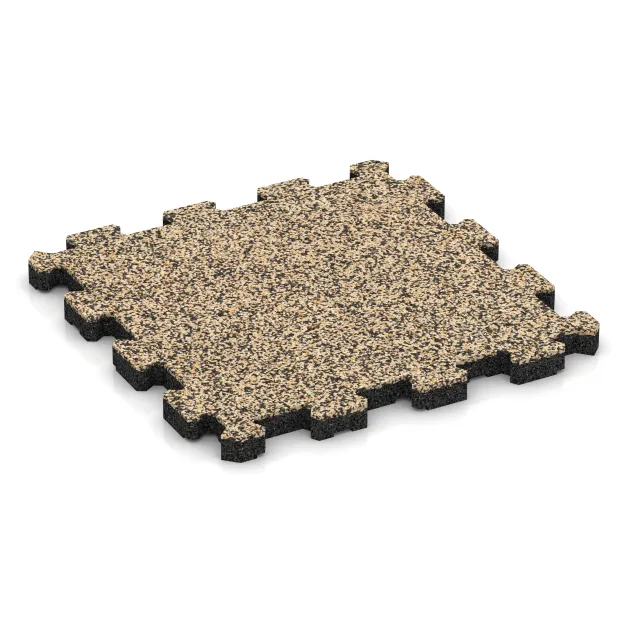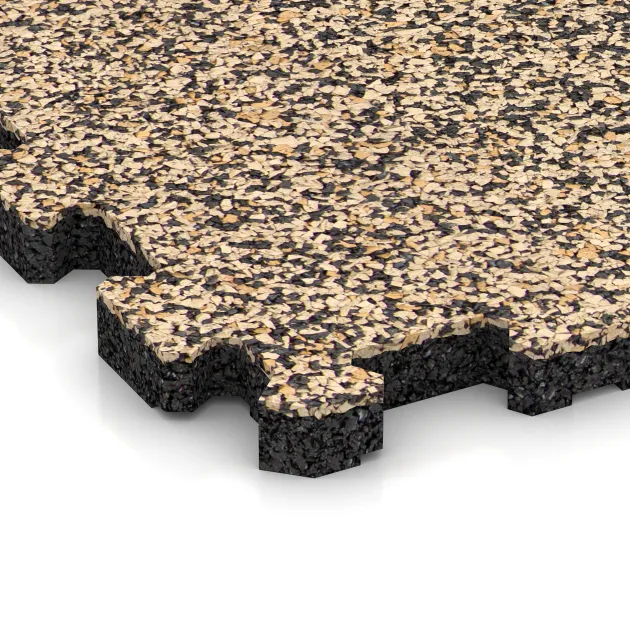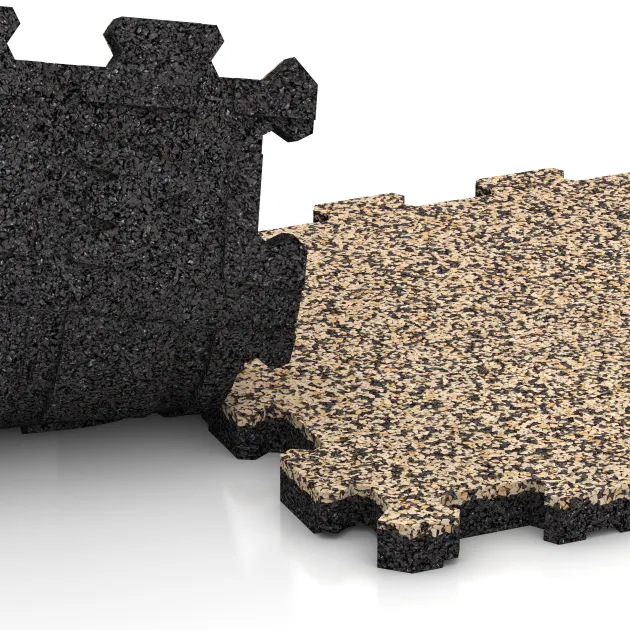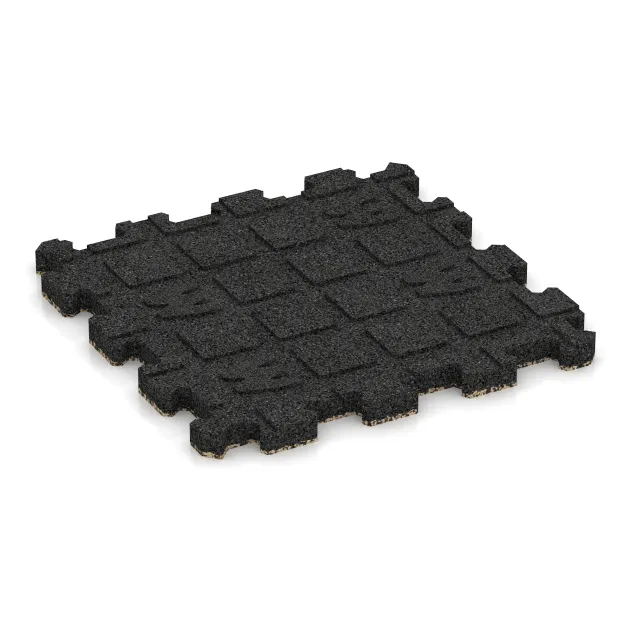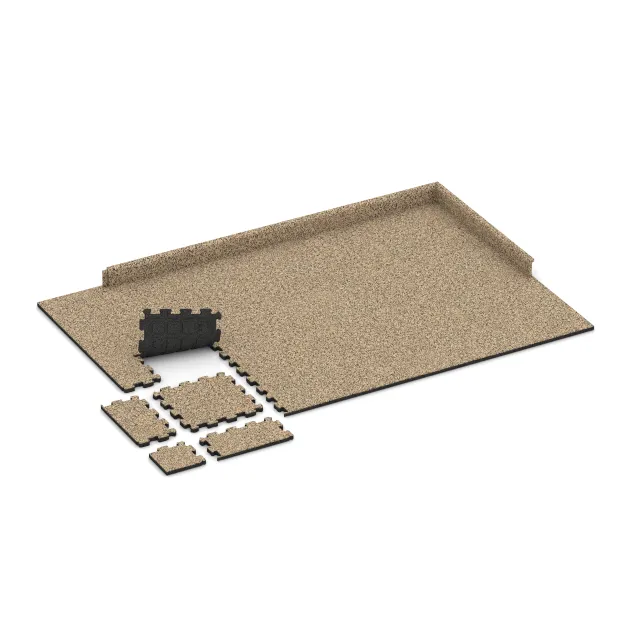Exhibition floor interlocking tile CZ "Travertine"
- /
-
Delivery in approx.
7-14 days - £66.24 / 10.68 Piece / m²
- (1.66 kg / Piece)
EAN: 4251469357402 | Item no.: 5740
The WARCO exhibition floor interlocking tile is precision-cut from a large-format slab that has undergone a multi-day curing and cool-down phase after manufacture. The 30.6 × 30.6 × 2 cm tile is therefore highly dimensionally stable – effectively calibrated. Square-cut, bevel-free edges produce a smooth, uniform floor appearance with joints that are barely noticeable.
Continuous jigsaw interlock
Each tile features a continuous jigsaw interlock. When installed, the interlock teeth along the tile edges engage precisely, forming a tight, load-bearing connection. Because the edges are cut square (with no chamfer), the interlock is virtually invisible in the finished surface, yielding a calm, uniform look.
Installation on rigid substrates
Install on rigid, sound substrates such as concrete, asphalt, screed, existing ceramic tiling or similar. The flooring tolerates slight unevenness and bridges minor chips or voids. The click interlock enables fast, clean, adhesive-free installation without special tools. After use, the tiles can be lifted just as easily, cleaned and stored for the next deployment.
Durable and functional
This exhibition floor made from PU-bonded rubber granulate is robust yet slightly resilient. The tiles are slip-resistant, shock-absorbing and reduce footfall noise. They are therefore particularly suitable for exhibition and event areas, showrooms and presentation spaces – wherever ergonomics, safety and an attractive finish are required.
Low-maintenance and reusable
The surface is resistant to mechanical wear, easy to clean and maintains its precise fit even after repeated installations. This makes the system a durable and cost-effective choice for temporary or frequently changing layouts.
Bringing calibrated dimensional accuracy together with a near-seamless finish and a precise jigsaw interlock, this tile has been developed specifically for professional exhibition and event use.
Discount
Product Highlights
Characteristics
Product Details – Material and Structure
Comparative values
To calculate how many tiles you need for your project, simply use the online installation planner available in the shop. This free browser-based tool is directly accessible on each product page – just below the price and quantity selection. Click on “Plan installation” to open the tool instantly – no registration or download required.
Enter the dimensions of your area, such as the length and width in metres. The planner will then automatically calculate the total number of tiles required, including a realistic allowance for offcuts. You’ll also be shown a suitable layout pattern for the selected product. The tool is user-friendly, accurate and ideal for planning your material requirements with confidence.
Yes, that is the standard approach. The vast majority of our customers – whether private, municipal, or commercial – install the delivered WARCO tiles themselves or with their own staff. The installation is simple and requires no special skills. Only fitting the curb into a concrete foundation with back support demands a little extra craftsmanship. Cutting the elements to size and laying them on a suitable substrate is not challenging. You can find all essential installation information in our Expert Advice – FAQ section on our website.
WARCO offers several connection systems for floor tiles, each differing in design, installation method and visual appearance. Below is an overview of the key differences:
Puzzle joint (visible)
In this system, the tile edges feature an interlocking profile reminiscent of classic jigsaw teeth or mushroom-shaped connectors. During installation, the profiles of adjacent tiles interlock to form a continuous connection across the full tile thickness.
The joint profile may be formed directly during pressing or precisely cut after the tile has cured. Whether the joint is visible in the finished surface depends on the edge finish (e.g. with or without chamfer) and the surface colouration.
The symmetrical shape ensures uniform load transfer and makes this type of joint the most mechanically stable option.
Plug-in connectors (plastic dowels)
This system uses separate connecting elements, typically round plastic dowels, which are inserted into pre-drilled holes along the sides of the tiles. The tiles themselves have smooth, straight edges similar to precast concrete slabs.
Installation is carried out in a half-bond (stretcher bond) pattern: each tile is connected via dowels to two tiles in the row above and two in the row below. This prevents lateral shifting, although some movement along the length of the dowels remains possible. For this reason, an edge restraint must be installed around the perimeter to stabilise the entire area.
Concealed puzzle joint
This method is based on the same mechanical principle as the classic puzzle joint, but is designed to be invisible in the finished surface. The interlocking profile is located on the underside of the tile, integrated into a rebated step joint.
Two tile edges feature a positive locking profile, the other two a matching negative profile. When laid, the tiles interlock securely from below, forming a durable mechanical connection. From above, the surface appears seamless and aligned, typically with a clean, square joint pattern similar to a chessboard layout.

